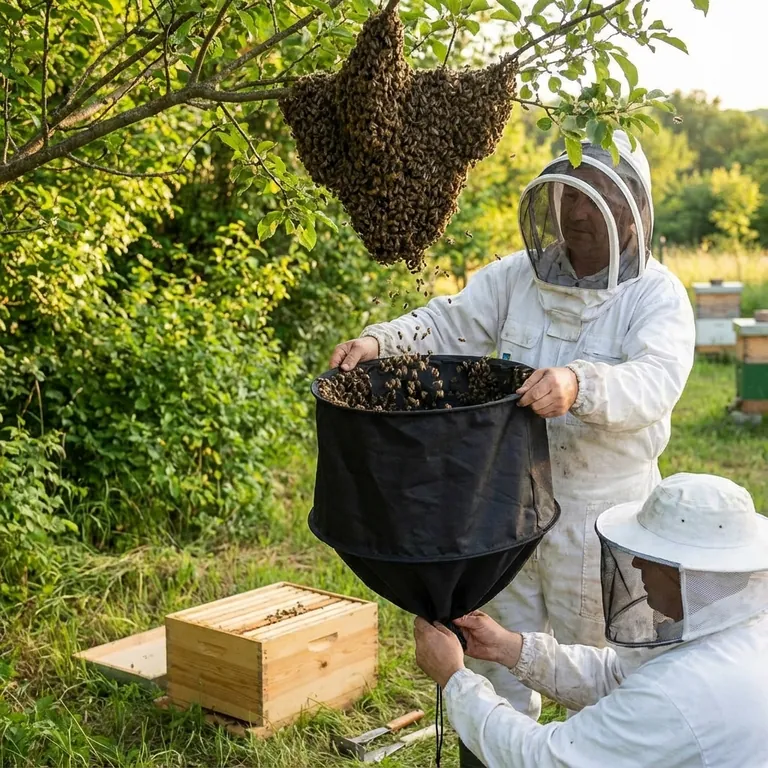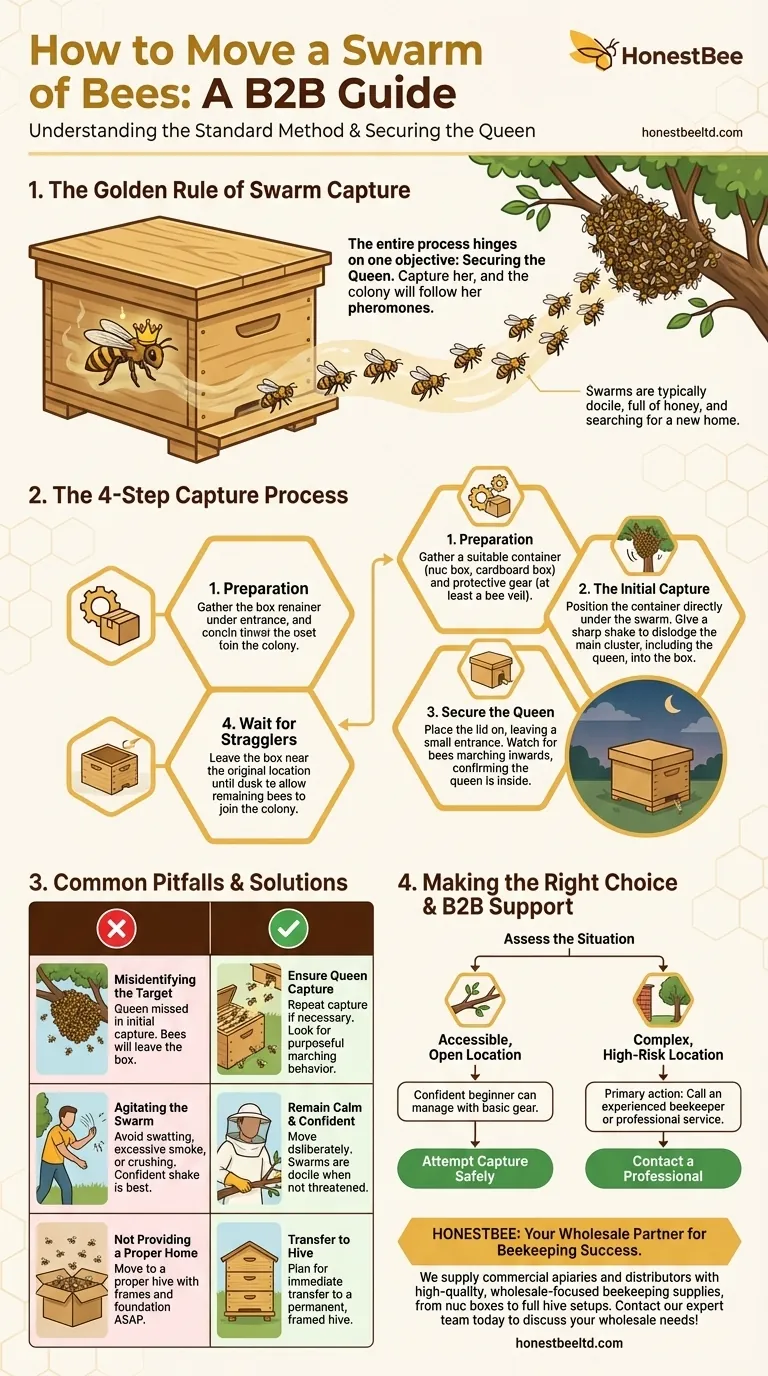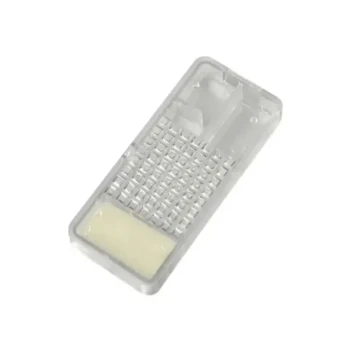The standard method for moving a swarm of bees is to capture the cluster, along with the queen, in a suitable container like a cardboard box or a dedicated beehive box. The key is to get the queen into the container; the rest of the worker bees will follow her scent and march inside on their own. This process capitalizes on the swarm's naturally docile state when they are searching for a new home.
The success of moving a swarm of bees does not depend on capturing every single bee. Instead, it hinges entirely on one critical objective: securing the queen. Once she is safely inside your container, the rest of the colony will follow.

Understanding Swarm Behavior
Why Bees Swarm
A swarm is not an angry mob of bees; it's a natural part of a honeybee colony's life cycle. When a hive becomes overcrowded, the old queen and about half the worker bees leave to find a new home.
This process, called swarming, is how bee colonies reproduce. The bees that leave gorge on honey before they go, making them full, content, and generally very docile.
The Central Role of the Queen
The swarm will temporarily cluster on a branch, fence post, or other object while scout bees search for a permanent residence.
The entire cluster is held together by the queen's pheromones—a unique chemical scent. Every bee in the swarm is focused on staying with her. This is the behavior you will use to your advantage.
The Capture Process: Step-by-Step
Step 1: Preparation is Key
Before you approach the swarm, prepare your equipment. You will need a container, which can be a simple cardboard box with air holes or, ideally, a spare hive box (a "nuc" or nucleus box is perfect).
You will also need protective gear. At a minimum, wear a bee veil to protect your face, even though swarms are typically gentle.
Step 2: The Initial Capture
Position your container directly underneath the swarm cluster. If the swarm is on a branch, you can often give the branch a single, sharp shake.
The goal is to dislodge the majority of the bee cluster, including the queen, so they fall directly into your open box.
Step 3: Securing the Queen
Once the main mass of bees is in the box, gently place the lid on but leave a small entrance gap. If you have successfully captured the queen, you will notice a change in the bees' behavior.
Bees remaining outside will stop flying erratically. Instead, they will begin to march purposefully toward the entrance of your box, following the queen's scent. This is the sign of a successful capture.
Step 4: Waiting for Stragglers
Leave the box near the original swarm location for a short period, often until dusk. This gives the remaining scout and worker bees time to find the queen and join the rest of the colony inside the box.
Once the bees have settled, you can seal the entrance and transport them to their new location.
Common Pitfalls and What to Avoid
Misidentifying the Target
The most common failure is not capturing the queen with the initial shake. If the bees do not start marching into the box and instead begin re-clustering on the original spot, you likely missed her. You will need to try again.
Agitating the Swarm
While swarms are docile, they can still sting if they feel threatened. Avoid swatting at them, using smoke excessively (it's often not needed for swarms), or making slow, crushing movements. A quick, confident shake is much more effective and less disruptive.
Not Providing a Proper Home
Simply capturing bees in a cardboard box is a temporary solution. They need to be moved into a proper beehive with frames and foundation as soon as possible, where they can begin building comb and raising a new generation.
When to Call a Professional
If the swarm is located in a difficult-to-reach or dangerous spot, such as high up in a tree, inside a wall, or near public areas, do not attempt to capture it yourself. Contact a local beekeeper or a professional bee removal service.
Making the Right Choice for the Situation
- If the swarm is in an accessible, open location (like a low-hanging branch): A confident beginner can often manage the capture with basic protective gear and a suitable box.
- If the swarm is in a complex or high-risk location (inside a structure or high off the ground): Your primary action should be to call an experienced local beekeeper or a professional removal service.
- If you are uncertain or anxious about the process: It is always wisest to ask for help. A local beekeeping association is an excellent resource for finding someone who can safely collect the swarm.
Understanding that a swarm's collective mind is focused entirely on its queen is the key to managing them safely and effectively.
Summary Table:
| Step | Key Action | Objective |
|---|---|---|
| 1. Preparation | Gather box, veil, and gear. | Ensure a safe and ready capture. |
| 2. Initial Capture | Shake swarm cluster into the box. | Dislodge the majority of bees and the queen. |
| 3. Secure the Queen | Place lid, leave an entrance gap. | Worker bees follow the queen's scent inside. |
| 4. Wait for Stragglers | Leave box near the spot until dusk. | Allow all bees to join the colony. |
Need reliable equipment for swarm management or expanding your apiary? As HONESTBEE, we supply commercial apiaries and beekeeping equipment distributors with high-quality, wholesale-focused beekeeping supplies. From nuc boxes to full hive setups, our equipment supports efficient and safe beekeeping operations. Let us help you equip your business for success—contact our expert team today to discuss your wholesale needs!
Visual Guide

Related Products
- HONESTBEE Collapsible Tiered Bee Swarm Catcher for Beekeeping
- Twin Queen Styrofoam Honey Bee Nucs Mating and Breeding Box
- Portable Bee Mating Hive Boxes Mini Mating Nucs 8 Frames for Queen Rearing
- Styrofoam Mini Mating Nuc Box with Frames Feeder Styrofoam Bee Hives 3 Frame Nuc Box
- Plastic Transporting Bee Packages and Nuc Boxes for Beekeeping
People Also Ask
- What information should be gathered before attempting to catch a swarm of bees? A Safe and Successful Guide
- What steps should be taken when approaching a swarm localized around many branches? A Guide to Safe and Efficient Capture
- What do beekeepers use to attract bees? Master Swarm Capture & Hive Management
- How to attract bees to a hive box? Proven Methods for Swarm Capture & Colony Expansion
- Do honey bees leave their hives? Understanding the Critical Role of Swarming



















